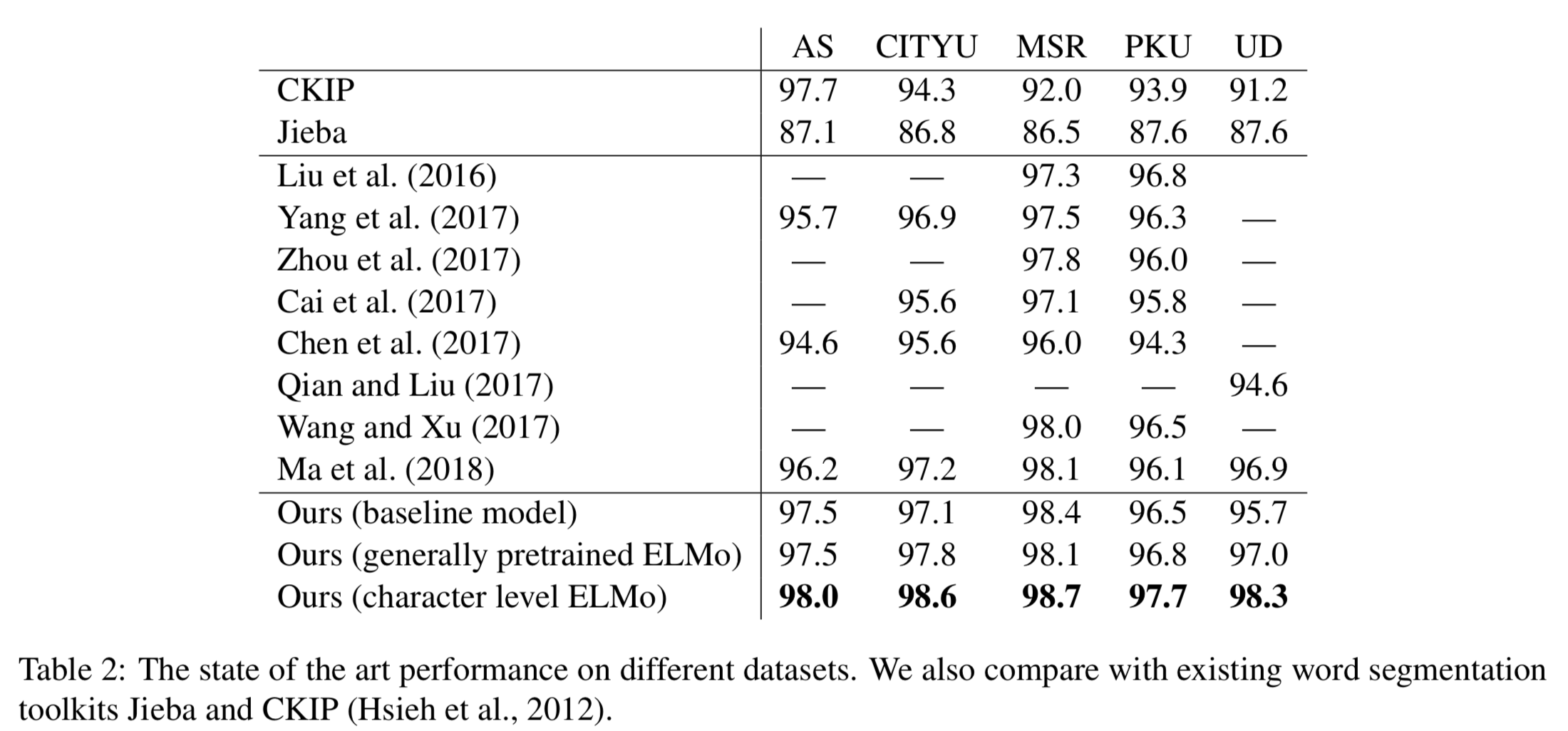Open source state-of-the-art Chinese word segmentation toolkit
Project description
Pywordseg
基於 BiLSTM 及 ELMo 的 State-of-the-art 開源中文斷詞系統。
An open source state-of-the-art Chinese word segmentation system with BiLSTM and ELMo.
- arXiv paper link: https://arxiv.org/abs/1901.05816
- PyPI page: https://pypi.org/project/pywordseg/
Performance
- 此專案提供圖中的 "character level ELMo" model 以及 "baseline" model,其中 "character level ELMo" model 是當前準確率最高。這兩個 model 都贏過目前常用的斷詞系統 Jieba (HMM-based) 及 CKIP (rule-based) 許多。
- This repo provides the "character level ELMo" model and "baseline" model in the figure. Our "character level ELMo" model outperforms the previous state-of-the-art Chinese word segmentation (Ma et al. 2018), and also largely outerform "Jieba" and "CKIP", which are most popular toolkits in processing simplified/traditional Chinese text.
- 當處理訓練時未見過的詞時,"character level ELMo" model 仍然保有不錯的正確率,相較於"baseline" model。
- When considering OOV accuracy, our "character level ELMo" model outperforms our "baseline" model about 5%.
Usage
Requirements
- python >= 3.6 (do not use 3.5)
- pytorch 0.4
- overrides
Install with Pip
$ pip install pywordseg- the module will automatically download the models while your first import within 1 minute.
- if you use MacOS and encounter the urllib.error.URLError problem when downloading your models,
try$ sudo /Applications/Python\ 3.6/Install\ Certificates.commandto bypass the certificate issue.
Install manually
$ git clone https://github.com/voidism/pywordseg- download ELMoForManyLangs.zip and unzip it to the
pywordseg/pywordseg(the code of the ELMo model is from HIT-SCIR, training by myself in character-level) $ pip install .under the main directory
Segment!
# import the module
from pywordseg import *
# declare the segmentor.
seg = Wordseg(batch_size=64, device="cuda:0", embedding='elmo', elmo_use_cuda=True, mode="TW")
# input is a list of raw sentences.
seg.cut(["今天天氣真好啊!", "潮水退了就知道,誰沒穿褲子。"])
# will return a list of lists of the segmented sentences.
# [['今天', '天氣', '真', '好', '啊', '!'], ['潮水', '退', '了', '就', '知道', ',', '誰', '沒', '穿', '褲子', '。']]
Parameters:
- batch_size: batch size for the word segmentation model, default:
64. - device: the CPU/GPU device to run you model, default:
'cpu'. - embedding: (default:
'w2v')'elmo': the loaded model will be the "character level ELMo" model above, which runs slow.'w2v': the loaded model will be the "baseline model" above, which runs faster than'elmo'.
- elmo_use_cuda: if you want your ELMo model be accelerated on GPU, use
True, otherwise the ELMo model will be run on CPU. This param is no use whenembedding='w2v'. default:True. - mode:
WordSegwill load different model according to the mode as listed below: (default:TW)TW: trained on AS corpus, from CKIP, Academia Sinica, Taiwan.HK: trained on CityU corpus, from City University of Hong Kong, Hong Kong SAR.CN_MSR: trained on MSR corpus, from Microsoft Research, China.CN_PKUorCN: trained on PKU corpus, from Peking University, China.
Include External Dictionary (Optional)
This feature was inspired by CKIPTagger.
# import the module
from pywordseg import *
# declare the segmentor.
seg = Wordseg(batch_size=64, device="cuda:0", embedding='elmo', elmo_use_cuda=True, mode="TW")
# create dictionary with their relative weights to prioritize.
word_to_weight = {
"來辦": 2.0,
"你本人": 1.0,
"或者是": 1.0,
"有興趣": 1.0,
"有興趣的": "2.0",
}
dictionary = construct_dictionary(word_to_weight)
print(dictionary)
# [(2, {'來辦': 2.0}), (3, {'你本人': 1.0, '或者是': 1.0, '有興趣': 1.0}), (4, {'有興趣的': 2.0})]
# 1) segment without dictionary.
seg.cut(["你本人或者是親屬有興趣的話都可以來辦理"])
# [['你', '本人', '或者', '是', '親屬', '有', '興趣', '的話', '都', '可以', '來', '辦理']]
# 2) segment with dictionary to merge words (only merge words that will not break existing words).
seg.cut(["你本人或者是親屬有興趣的話都可以來辦理"], merge_dict=dictionary)
# [['你本人', '或者是', '親屬', '有興趣', '的話', '都', '可以', '來', '辦理']]
# merged: '你', '本人' --> '你本人'
# merged: '或者', '是' --> '或者是'
# merged: '有', '興趣' --> '有興趣'
# not merged: '來', '辦理' -x-> '來辦', '理' because it breaks existing words
# 3) segment with dictionary that force words to be segmented (ignore existing words).
seg.cut(["你本人或者是親屬有興趣的話都可以來辦理"], force_dict=dictionary)
# [['你本人', '或者是', '親屬', '有興趣的', '話', '都', '可以', '來辦', '理']]
# merged: '你', '本人' --> '你本人'
# merged: '或者', '是' --> '或者是'
# change: '有興趣', '的話' --> '有興趣的', '話'
# change: '來', '辦理' --> '來辦', '理'
TODO
- 目前只支援繁體中文(即使選擇CN mode,文字也要轉換成繁體才能運作,目前訓練資料都是經過 OpenCC 轉換的),日後會加入簡體中文。
Citation
If you use the code in your paper, then please cite it as:
@article{Chuang2019,
archivePrefix = {arXiv},
arxivId = {1901.05816},
author = {Chuang, Yung-Sung},
eprint = {1901.05816},
title = {Robust Chinese Word Segmentation with Contextualized Word Representations},
url = {http://arxiv.org/abs/1901.05816},
year = {2019}
}
Project details
Release history Release notifications | RSS feed
Download files
Download the file for your platform. If you're not sure which to choose, learn more about installing packages.
Source Distribution
pywordseg-0.1.4.tar.gz
(12.1 kB
view details)
Built Distribution
pywordseg-0.1.4-py3-none-any.whl
(10.8 kB
view details)
File details
Details for the file pywordseg-0.1.4.tar.gz.
File metadata
- Download URL: pywordseg-0.1.4.tar.gz
- Upload date:
- Size: 12.1 kB
- Tags: Source
- Uploaded using Trusted Publishing? No
- Uploaded via: twine/3.4.1 importlib_metadata/4.0.1 pkginfo/1.7.0 requests/2.25.1 requests-toolbelt/0.9.1 tqdm/4.60.0 CPython/3.8.3
File hashes
| Algorithm | Hash digest | |
|---|---|---|
| SHA256 |
2ce58dbc40660d1bf11f4c9844d824189c41023159b9a488e387fff6af3ae0c5
|
|
| MD5 |
b2e87d91d55e1cde6843ebe948026837
|
|
| BLAKE2b-256 |
351e3b175681b8bbf4d9c06f410f9daf054013933a3206deaaca7956b7f6b42d
|
File details
Details for the file pywordseg-0.1.4-py3-none-any.whl.
File metadata
- Download URL: pywordseg-0.1.4-py3-none-any.whl
- Upload date:
- Size: 10.8 kB
- Tags: Python 3
- Uploaded using Trusted Publishing? No
- Uploaded via: twine/3.4.1 importlib_metadata/4.0.1 pkginfo/1.7.0 requests/2.25.1 requests-toolbelt/0.9.1 tqdm/4.60.0 CPython/3.8.3
File hashes
| Algorithm | Hash digest | |
|---|---|---|
| SHA256 |
b410051f7703e744b06602a90adf4f79d56d207a0a398ccdda27739846a402ed
|
|
| MD5 |
2d5ce86da71f5e59ddfe371d0dd90e80
|
|
| BLAKE2b-256 |
74cc3c208f90aaf8ff186fa9d93158ec417da56eea5eaf8682e3718b877cbdbe
|












